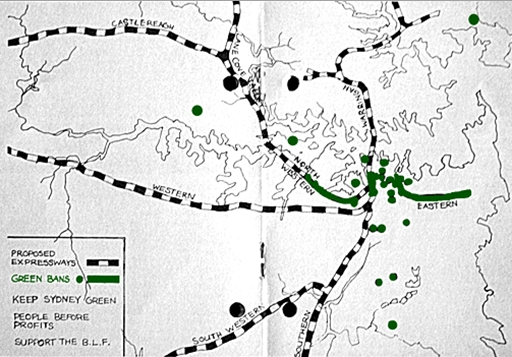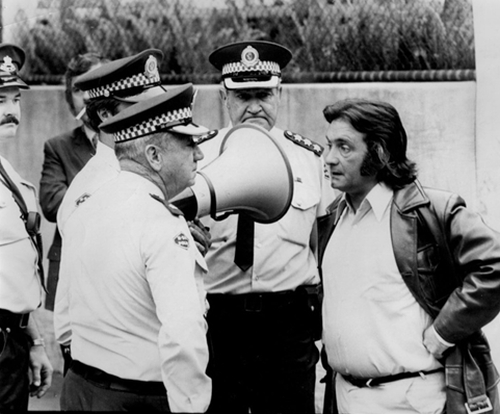That being a builder’s labourer was a dangerous occupation in the 1960s and ’70s was indisputable; as in the year that ended in April 1973, 44 building workers were killed on the job in NSW. Jack Mundey was elected secretary of the NSW Branch in 1968; he came to play a very important part as a leader, not only in improving working conditions and wages for labourers in a very dangerous occupation, but also in helping local resident action groups preserve their environment against the attempts by property developers to build houses and office blocks primarily for profit and without regard for the effects on residents. It was the last of these activities that came to be known as the ‘green bans’.
The first of the green bans was the 1970 campaign to save Kelly’s Bush in Hunters Hill. Other green bans included the working class area of the Rocks, Woolloomooloo and Victoria St at Kings Cross. There were also green bans placed on the demolition of the Theatre Royal in Sydney and the Capitol Theatre in Inverell. The Theatre Royal was saved as a result of a compromise whereby the original theatre was demolished but a new theatre incorporated into the high rise building which replaced it. The battle for the Capitol at Inverell was lost, much to the subsequent regret of many of the town’s citizens.
On the initiative of Bernard Smith, professor of Fine Arts at the University of Sydney, and his wife, Kate, the Glebe society was founded in 1969. Its aims were set forth in its first newsletter:
The Society will concern itself with the problems threatening Glebe as a pleasant place to live. Our approach will be two-pronged, to ensure that adequate thought and planning goes into new projects in the area and to preserve and conserve what is good in the already existing buildings and places of historic interest.
Although there were other issues, such as industrial pollution and unsympathetic architecture that led to the founding of The Glebe Society, it soon became clear that the greatest threat to the suburb was the proposal of the Department of Main Roads (DMR) to build expressways through Glebe. As the Society’s president Peru Perumal later wrote: ‘if the proposed expressways were built as planned, they would isolate a very closely knit community into three distinct sections. These sections would not have natural topographical, geographical, sociological or townscape divisions’.

Denis Winston’s book Sydney’s Great Experiment clearly shows plans for the Western and North-Western Expressways through Glebe. The Western Expressway was to join the Great Western Highway west of Parramatta and the North-Western to cross the Parramatta River at Gladesville and join the Pacific Highway north of Mt Colah.
In 1970 the Society wrote to the Minister for Local Government and Highways, Mr Morton, expressing concern that ‘the plan for the proposed North Western Expressway is shown on the map of the City of Sydney Planning Scheme as a tunnel between Palmerston Ave and Maxwell Rd, Glebe’. It took some time before Bernard Smith received an assurance from Mr Morton that ‘the North-Western expressway through Glebe … will be a driven tunnel’. This would at least have alleviated the great inconvenience caused by open cut construction. Bulletin No.2 of 1971 has a front-page editorial expressing strong opposition to expressways.
A Bulletin item in 1972 acknowledging the receipt of a donation from the Glebe Society to the Leichhardt Anti-Expressway Committee is a reminder that opposition to the expressways was not confined to Glebe residents. Bulletin No. 2 of 1973 gave notice of an ‘ANTI-EXPRESSWAY MEETING organised by Leichhardt Council at Leichhardt Town Hall’.
The next Bulletin had a contribution by Albert Mispel containing a reference to correspondence with Tom Uren, the Minister for Urban and Regional Development in the recently elected Whitlam government who was to play a very important part in the eventual defeat of the expressway proposals. Bulletin No.5 of 1973 contained a letter from the Society’s president Peru Perumal reminding Mr Uren of his pre-election promises and asking for urgent action to forestall the state government. In reply Mr Uren wrote ‘It is heartening to me to see your continuing concern for the future of our cities. You can be assured of my continued support for your Society’s efforts to protect the environmental and social values of your community.’ The acquisition of the Glebe estate from the Anglican Archdiocese of Sydney was partly in order to prevent the state government from resuming land for the Western Expressway.
Bulletin No.10 of 1973 contained a letter written to the Sydney Morning Herald on behalf of the Society, The Annandale Association, the Glebe Anti-Expressway Group and the Save Lyndhurst Committee, reviewing ‘the conditions of two of the green bans enforced by the Builders’ Labourers’ Federation – the demolition of Lyndhurst and the construction of the North-Western Expressway.’ Jack Mundey, Joe Owens and the NSW branch of the BLF were to prove valuable allies.

In their book Green Bans, Red Union (1998), Meredith and Verity Burgmann told how the NSWBLF became involved in the fight to stop the expressways. None of their officials owned cars and neither did most of the residents of the inner city suburbs who would be most affected. The DMR ignored the many protest motions passed by the Anti-Urban Radial Expressway Committee and continued to demolish houses which had been compulsorily resumed. Active protest came to a head in the battle of Fig St which, as reported by Allan Sorrenson in the Bulletin No.2 (March) of 1975:
saw hundreds of residents turning out in a spontaneous demonstration against the DMR’s policies. For one long week Fig St Ultimo was THE place to be. Residents, bulldozers, police, politicians and the media were there. Tension was high. Twelve people were arrested. But a real community spirit pervaded and the residents prevailed.
In an article headed EXPRESSWAYS the Bulletin No.8 (October) of 1975 gives a ‘précis of a recent talk by Alan Sorrenson, spokesman for the Save the Public Transport Committee and Senior Vice-President of the Glebe Society, on the radio programme Overdrive ‘taking into account the energy crisis, the efficiency of the motor vehicle in the way it transports people, and the social questions involved.’
The Society was not only highly critical of the expressway proposals but in a series of occasional monographs argued for alternative solutions to the problems which the expressways were supposed to solve.
The election of the Wran government in 1976 brought a temporary halt to the DMR’s plans but in a publication of the Inner Sydney Regional Transport Group, Stop Them Resurrecting Askin’s Freeways (1986), Stephen Harris, Senior Lecturer in Town Planning, University of NSW, stated that ‘the transport plans of the mid-1980s remain firmly based on those of the mid-1940s – because the DMR has a long memory and has at last talked the government around to the plans it has always had its heart set on.’
Mundey wrote that low income people ‘in the Loo and elsewhere in the inner city were being uprooted and distributed around the far-flung western and south-western outer suburbs’ and folk singer Declan Affley sang:
Under concrete and glass, Sydney’s disappearing fast
It’s all gone for profit and for plunder,
Though we’d really like to stay,
They are driving us away,
And across the western suburbs we must wander.
Click here to listen to the song
Mundey acted as the public face of the green bans in the early 1970s, supported by the union and Bob Pringle and Joe Owens in particular. He believed that trade unions should campaign not only about working conditions but also about the rights of women, homosexuals and Aborigines He made many enemies and must have been sorely tempted by the bribes he was offered although he never accepted any of them. New South Wales and the city of Sydney in particular owe him a huge debt of gratitude.
Recommended reading: Burgmann, Meredith and Verity Burgmann. Green Bans, Red Union: The Saving of a City 2017;
Colman, James The House that Jack Built – Jack Mundey, Green Bans Hero, 2016;
Glebe Society Bulletins (held in the Glebe library).
Mundey, Jack. Jack Mundey: Green Bans and Beyond. 1981.
Solling, Max. Grandeur & Grit: A History of Glebe 2007.
Click here a talk by Jack Mundey on “Resident Action Groups” given to the Glebe Society on the occasion of its 40th Anniversary.









There are no comments yet. Please leave yours.